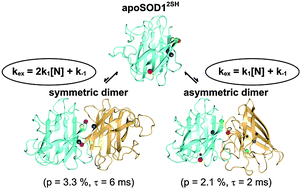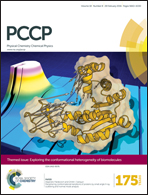Evolution of magnetization due to asymmetric dimerization: theoretical considerations and application to aberrant oligomers formed by apoSOD12SH
Abstract
A set of coupled differential equations is presented describing the evolution of magnetization due to an exchange reaction whereby a pair of identical monomers form an asymmetric dimer. In their most general form the equations describe a three-site exchange process that reduces to two-site exchange under certain limiting conditions that are discussed. An application to the study of sparsely populated, transiently formed sets of aberrant dimers, symmetric and asymmetric, of superoxide dismutase is presented. Fits of concentration dependent CPMG relaxation dispersion profiles provide measures of the dimer dissociation constants and both on- and off-rates. Dissociation constants on the order of 70 mM are extracted from fits of the data, with dimeric populations of ∼2% and lifetimes of ∼6 and ∼2 ms for the symmetric and asymmetric complexes, respectively. This work emphasizes the important role that NMR relaxation experiments can play in characterizing very weak molecular complexes that remain invisible to most biophysical approaches.

- This article is part of the themed collection: Exploring the conformational heterogeneity of biomolecules: theory and experiments

 Please wait while we load your content...
Please wait while we load your content...